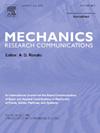Transverse vibration of an embedded nanotube made of functionally graded porous material based on NSGT
IF 2.3
4区 工程技术
Q3 MECHANICS
引用次数: 0
Abstract
The present work focuses on examining the transverse vibration behavior of a functionally graded porous nanotube resting on a Winkler–Pasternak elastic foundation, incorporating size-dependent effects and deformable boundary conditions. An analytical approach based on nonlocal strain gradient theory is adopted, which accounts for small-scale effects through two distinct size parameters—one with a strengthening effect and the other with a weakening effect. For the first time, deformable boundary conditions are considered the functionally graded porous nanotube in this context. An eigenvalue problem is formulated using the Stokes' transform, with constant coefficients assigned to the springs, along with Winkler–Pasternak foundation coefficients, material properties, and scale parameters. The resulting characteristic equation is solved analytically for various values of foundation stiffness, elastic spring parameters, strain gradient, and nonlocal effects to determine the system’s vibration frequencies. A comparative assessment with earlier research is conducted to validate the findings, confirming their accuracy. Then, the effects of small-scale parameters, volume fraction index, deformable boundaries, elastic foundation, rotary inertia and porosity density are discussed.
基于NSGT的功能梯度多孔材料嵌入纳米管的横向振动
本文主要研究了基于温克勒-帕斯捷尔纳克弹性地基的功能梯度多孔纳米管的横向振动行为,并考虑了尺寸相关效应和可变形边界条件。采用基于非局部应变梯度理论的解析方法,通过两个不同的尺寸参数(一个具有增强效应,另一个具有减弱效应)来解释小尺度效应。本文首次将可变形边界条件考虑到功能梯度多孔纳米管中。本征值问题是用Stokes变换来表示的,弹簧的系数是恒定的,还有温克勒-帕斯捷尔纳克基础系数、材料特性和尺度参数。对得到的特征方程进行了基础刚度、弹性弹簧参数、应变梯度和非局部效应的解析求解,从而确定了系统的振动频率。与早期的研究进行比较评估,以验证研究结果,确认其准确性。然后,讨论了小尺度参数、体积分数指数、变形边界、弹性基础、旋转惯量和孔隙率密度的影响。
本文章由计算机程序翻译,如有差异,请以英文原文为准。
求助全文
约1分钟内获得全文
求助全文
来源期刊
CiteScore
4.10
自引率
4.20%
发文量
114
审稿时长
9 months
期刊介绍:
Mechanics Research Communications publishes, as rapidly as possible, peer-reviewed manuscripts of high standards but restricted length. It aims to provide:
• a fast means of communication
• an exchange of ideas among workers in mechanics
• an effective method of bringing new results quickly to the public
• an informal vehicle for the discussion
• of ideas that may still be in the formative stages
The field of Mechanics will be understood to encompass the behavior of continua, fluids, solids, particles and their mixtures. Submissions must contain a strong, novel contribution to the field of mechanics, and ideally should be focused on current issues in the field involving theoretical, experimental and/or applied research, preferably within the broad expertise encompassed by the Board of Associate Editors. Deviations from these areas should be discussed in advance with the Editor-in-Chief.

 求助内容:
求助内容: 应助结果提醒方式:
应助结果提醒方式:


